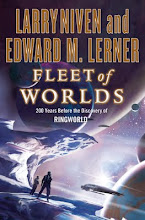One of the biggest mysteries of physics (and life, the universe, and everything) is this: why is anything even here?
In physics, the question crops up at two levels. First, why did the Big Bang happen? Second, once the Big Bang did happen, matter and antimatter were, per theory, created in equal quantities. So: why didn't the universe's matter and antimatter eradicate each other and leave behind nothing but energy?
(I'm not complaining that we're here. Merely puzzled.)
Tuesday, January 25, 2011
Antimatter matters
Posted by
Edward M. Lerner
at
12:37 PM
Labels:
ed's fiction,
InterstellarNet,
physics,
space exploration,
technology
Monday, January 17, 2011
Cyber war
If you visit this blog with any regularity, you'll know that I'm a technophile. That said, for all the many wondrous things technology offers, it also creates new ways to become vulnerable. One vulnerability I particularly monitor is attacks on our increasingly networked infrastructure.
Recent years have offered inklings of cyber warfare.
Recent years have offered inklings of cyber warfare.
- In 2007, after Russia took umbrage over Estonia removing a Soviet-era war memorial, Estonia blamed Russia for a massive denial-of-service attack on government servers.
- In 2008, the Georgian government claimed Russian cyber attacks accompanied the more visible aggression of bombings and troop incursions.
- In 2010, Google and many other American companies were attacked by Chinese hackers. Almost immediately the rumor was that at least the attack on Google was geopolitically motivated, orchestrated by the Chinese government. A recent WikiLeaks data dump of American diplomatic cables backs the theory of Chinese leadership involvement. And it was Google who hacked right back, although as far as I've read, the counter hack was (perhaps wisely) limited to collecting evidence.
- A case can be made that the 2010 WikiLeak disclosures were a form of nongovernmental cyber war waged against the U.S. government (and/or other governments whose laundry was aired by these leaks). See "Why WikiLeaks Is Unlike the Pentagon Papers."
Posted by
Edward M. Lerner
at
4:15 PM
Labels:
current events,
ed's fiction,
fools' experiments,
technology
Tuesday, January 11, 2011
Getting smashed
No, not a New Year's Eve hangover retrospective. Rather, reflections on the near-term prospects for particle accelerators (what in my youth we called atom smashers).
UPDATED FEBRUARY 1, 2011
First came word that the brand-new, scarcely operational Large Hadron Collider would will shut down for maintenance throughout 2012. Then CERN, the trans-European organization that runs the LHC, announced the shutdown will last more than a year and that they'll also be shutting down the rest of their accelerators in 2012.
UPDATE (2/1/2011): CERN has reconsidered. The LHC will continue running in 2012. Yea!
Now comes word that FermiLab plans to turn off the Tevatron later this year.
UPDATED FEBRUARY 1, 2011
First came word that the brand-new, scarcely operational Large Hadron Collider would will shut down for maintenance throughout 2012. Then CERN, the trans-European organization that runs the LHC, announced the shutdown will last more than a year and that they'll also be shutting down the rest of their accelerators in 2012.
UPDATE (2/1/2011): CERN has reconsidered. The LHC will continue running in 2012. Yea!
Now comes word that FermiLab plans to turn off the Tevatron later this year.
Monday, January 3, 2011
Head in the clouds
One of the hottest ideas in information technology these days is "cloud computing."
The expression originates in an early Internet convention: customer-centric drawings that showed detail of Internet connectivity only at the end points. That is, you're likely to care how your computer (or phone) connects to the Internet. You're likely to care about the server that's providing a function to you. And the gear that lies between? The redundant components and fail-over mechanisms and keen in-the-background software that make the Internet resilient? For most end users, not so much.
To network engineers, those "between" things -- routers and comm links and protocol stacks and specialty servers for background functions like domain-name look-ups -- are, collectively, "the cloud." And so, many a network diagram (like the one nearby) shows connections into and out of a featureless cloud.
The expression originates in an early Internet convention: customer-centric drawings that showed detail of Internet connectivity only at the end points. That is, you're likely to care how your computer (or phone) connects to the Internet. You're likely to care about the server that's providing a function to you. And the gear that lies between? The redundant components and fail-over mechanisms and keen in-the-background software that make the Internet resilient? For most end users, not so much.
To network engineers, those "between" things -- routers and comm links and protocol stacks and specialty servers for background functions like domain-name look-ups -- are, collectively, "the cloud." And so, many a network diagram (like the one nearby) shows connections into and out of a featureless cloud.
Subscribe to:
Comments (Atom)

































